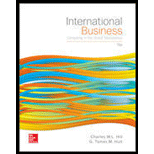
To determine: The shifts in the world economy over the last 30 years and the impact of the shift for the international business.
Introduction:
Globalization is the process used by the company to influence their business internationally and the process of doing business globally.
Explanation of Solution
Determine the shifts in the world economy over the last 30 years and the impact of the shift for international business:
There are conditions in which the world’s economies of the nation has differences in business systems, cultures, and government regulations. The world in which the national economies are isolated by trade barriers and they are self-contained entities.
Over the past three decades, there has been a shift away in the economies of the nation. There is a decline in the trade and investment barriers. National economies are merging into the integrated global economic system and the cultures are converging. Companies from Country U and western region of Continent was diminished when the companies from Country C and Country J began to play a major role in world economy.
In the developing countries, the spending power of the customers was growing quickly. International business based in Country U, Country C, and Country H are facing both threats and opportunities due to the shift in the world economy.
Want to see more full solutions like this?
Chapter 1 Solutions
International Business: Competing in the Global Marketplace
- RK Co. sells snowboards. Each snowboard requires direct materials for $140, direct labor for $55, and variable overhead of $64. The company expects fixed overhead costs of $673,000 and fixed selling and administrative costs of $160,000 for the next year. It expects to produce and sell 11,900 snowboards in the next year. What will be the selling price per unit if RK uses a mark-up of 17% of the total cost?arrow_forwardSP Company made sales of $32,750 million in 2019. The cost of goods sold for the year totaled $12,500 million. At the end of 2018, Malt's inventory stood at $1,300 million, and SP ended 2018 with an inventory of $1,800 million. Compute Malt's gross profit percentage and rate of inventory turnover for 2019.arrow_forwardSuppose Austin Sound had sales of $450,000 and sales returns of $55,000. Cost of goods sold was $176,000. How much gross profit did Austin Sound report?arrow_forward
- The company's total assets arearrow_forwardQuestion 2 MGMT2026 Production and Operations Management Semester II 2024-2025 a. Aman ltd. desires to locate a new facility. Based on preliminary analysis, the choice has been reduced to four locations: A, B, C, and D. These four locations were rated on a scale from 1 (worst) to 10 (best) on each of four criteria. Each criterion was also weighted to indicate its importance (i.e., the higher the weight, the more important). The list of ratings and weights follows in the Table 2 below: Table 2 Factor Score Evaluation by Location Criterion Weights A B с D Wages 25 4 5 3 4 Government Policies 30 8 7 6 5 Unionisation Weather 15 6 4 3 2 30 3 4 6 5 i. Based on weighted scores, where should Acme locate its new facility? [6 marks] b. An operations manager has narrowed down the search for a new factory to three locations. The fixed and variable costs associated with each location is given in the table below. i. Table 3 Location Fixed Cost Variable Cost A $100,000 $10 B $150,000 $7 с $200,000 $5…arrow_forwardRight Answerarrow_forward
- Provide answer this financial accounting question answer will be accurate and step by step calculationarrow_forwardMoose Enterprises finds it is necessary to determine its marginal cost of capital. Moose’s current capital structure calls for 50 percent debt, 30 percent preferred stock, and 20 percent common equity. Initially, common equity will be in the form of retained earnings (Ke) and then new common stock (Kn). The costs of the various sources of financing are as follows: debt, 9.6 percent; preferred stock, 9 percent; retained earnings, 10 percent; and new common stock, 11.2 percent. a. What is the initial weighted average cost of capital? (Include debt, preferred stock, and common equity in the form of retained earnings, Ke.) b. If the firm has $18 million in retained earnings, at what size capital structure will the firm run out of retained earnings? c. What will the marginal cost of capital be immediately after that point? (Equity will remain at 20 percent of the capital structure, but will all be in the form of new common stock, Kn.) d. The 9.6 percent cost of debt referred to earlier…arrow_forwardWhat was the direct labor cost?arrow_forward
- What are the estimated cash receiptsarrow_forwardWhat was the cash balance on November 1 ?arrow_forward7. Berkeley Farms wants to determine the minimum cost of capital point for the firm. Assume it is considering the following financial plans: Cost (aftertax) Weights Plan A Debt .................................. 4.0% 30% Preferred stock .................. 8.0 15 Common equity ................. 12.0 55 Plan B Debt .................................. 4.5% 40% Preferred stock .................. 8.5 15 Common equity ................. 13.0 45 Plan C Debt .................................. 5.0% 45% Preferred stock .................. 18.7 15 Common equity ................. 12.8 40 Plan D Debt .................................. 12.0% 50% Preferred stock .................. 19.2 15 Common equity ................. 14.5 35 a. Which of the four plans has the lowest weighted average cost of capital? Use the Kd (cost of debt) = Y(1 - T), Kp (Cost of preferred stock) = Dp/Pp - F, Ke = D1/P0 + g formulas or I will not understand.arrow_forward
 Foundations of Business (MindTap Course List)MarketingISBN:9781337386920Author:William M. Pride, Robert J. Hughes, Jack R. KapoorPublisher:Cengage Learning
Foundations of Business (MindTap Course List)MarketingISBN:9781337386920Author:William M. Pride, Robert J. Hughes, Jack R. KapoorPublisher:Cengage Learning Foundations of Business - Standalone book (MindTa...MarketingISBN:9781285193946Author:William M. Pride, Robert J. Hughes, Jack R. KapoorPublisher:Cengage Learning
Foundations of Business - Standalone book (MindTa...MarketingISBN:9781285193946Author:William M. Pride, Robert J. Hughes, Jack R. KapoorPublisher:Cengage Learning- MarketingMarketingISBN:9780357033791Author:Pride, William MPublisher:South Western Educational Publishing
 Understanding Management (MindTap Course List)ManagementISBN:9781305502215Author:Richard L. Daft, Dorothy MarcicPublisher:Cengage Learning
Understanding Management (MindTap Course List)ManagementISBN:9781305502215Author:Richard L. Daft, Dorothy MarcicPublisher:Cengage Learning





